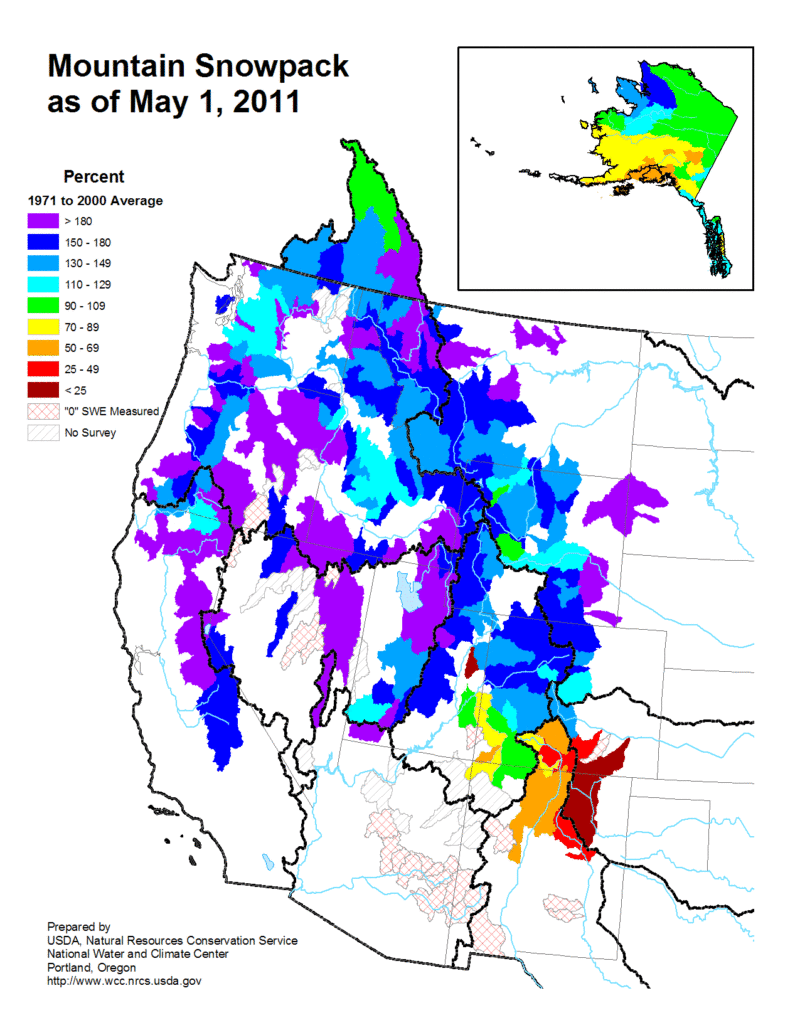A new study finds large losses of springtime snow cover in the West in recent years, raising concerns about water supplies.
![news_alyson_south[2]](http://ww2.kqed.org/climatewatch/wp-content/uploads/sites/54/2011/06/news_alyson_south2.jpg)
This spring, from the Pacific Northwest and Sierra Nevada, to the Northern Rockies, western mountain ranges were more than just snow-capped – they were buried in the white stuff. In fact, many locations still have more spring snowpack than has been seen in decades.
Head south across the 40th parallel, however, and things are dramatically different. While there is still above average snow throughout the Sierra, a relatively snow-less winter and spring has left much of the Southwest in a drought that has fostered record wildfires. Already local officials are worried there won’t be enough water to get through the summer months ahead.
This kind of contrast for the western spring snowpack is not unusual, though. It’s completely normal, and it’s exactly what climate scientists and meteorologists expect during years when the average weather pattern is influenced by La Niña, a climate cycle associated with cooler than average water temperatures in the tropical Pacific Ocean.
But while this north-south dichotomy turns out to be a regular feature of western climate, new research published today in the journal Science shows that, when compared to typical snowfall during the past 1,000 years, snowpack patterns appear to be changing as average temperatures climb. Scientists say that as temperatures continue to rise, this reduced snowpack will lead to more frequent water shortages in increasingly thirsty western states.
“We’re talking about simultaneous snowpack decline in the western watershed that supports 70 million people,” says U.S. Geological Survey (USGS) climatologist Julio Betancourt, who co-authored the new study. “We have to be concerned.”
For several years, scientists have observed that spring snowpack all across the West — in both northern and southern areas — has been decreasing. But now, Betancourt and a group of other climate scientists have found that the recent decline is a departure from patterns of the past 1,000 years. As part of the study published in Science, USGS ecologist Greg Pederson investigated tree ring data to learn how snowpack in the West, on either side of 40th parallel, changed from year-to-year and from decade-to-decade. Looking back over nearly a millennium, he found that when the north had high snowpack, the south typically experienced low snowpack, and vice versa.
But Pederson and Betancourt noticed a change starting in the mid-1980’s. On average, the amount of snow on the ground at the beginning of April each year was decreasing everywhere across the West. It’s a trend that other scientists studying snowpack have pointed out. This has important consequences for water supplies for drinking water and agriculture, since many areas, including much of interior California, are dependent upon spring runoff for much of their water supplies.
Betancourt says that as average spring temperatures have risen, the snowpack has begun to melt earlier in the year (not the case this year, with record cold weather locking in substantial amounts of snow in many western ranges). Moreover, he says that in many places, the warmer temperatures mean that precipitation falls more as rain than as snow. So while the actual amount of precipitation hasn’t changed dramatically, the amount of rain has.

“Snowpack is the water resources of the West,” says Greg McCabe, a USGS hydrology expert who was not directly involved in the new study, “and temperature has a dominant impact on the snowpack.” If warming temperatures in the West cause the snowpack to decrease even more, McCabe says, or if the timing of the melt each spring changes, then summer water shortages could happen a lot more often.
McCabe says the research provides valuable evidence about how snowpack has changed historically, and also how unusual the recent patterns appear to be.
According to Pederson and Betancourt’s findings, the way snowpack has changed in the past 30 years isn’t entirely unprecedented. There were two brief periods in the mid-1300’s and early 1400’s where there was less snow built up throughout the West.
“At both those other times in the past, we know it was warm then too,” explains Betancourt.
Now, however, climate scientists are predicting that average temperatures in the West are going to keep rising this century, due in large part to the buildup of greenhouse gases in the atmosphere. Compared to the past, when snowfall returned to normal as temperatures dropped, researchers now expect that warmer spring weather could keep spring snowpack on the decline for years to come.
“What’s happening in the spring for snow is critically important [for water availability] compared to what is happening in the dead of winter,” says Betancourt.
So what do the authors make of a year like this, which has brought frequent snowfall to the Sierra, even into June?
“There isn’t anything that has happened this year that isn’t consistent with what our new findings are,” says Pederson. Even as average temperatures increase in the coming years, there will still be cool years where above average snowpack builds up in parts of the West, particularly during La Niña years. “But these years will tend to be weather noise over top of the larger climate changes we will see over many years,” he says.
NPR’s Richard Harris interviews Pederson in this story for Morning Edition.
A version of this post also appears at Climate Central, a content partner of KQED Climate Watch.
2 thoughts on “Forget this Winter: Western Snowpack Shrinking”
Comments are closed.

Thanks for posting this. The abstract for the Science article may be found here – http://bit.ly/ld5mFQ
Hi,
Has anyone noticed that the data was truncated at 2006 and that the snow pack has increased since then. Dr Christy looked at the Sierra Snow pack from 1906 to 2009 and found no trend. There is more on this attempt to scare people here:
http://wattsupwiththat.com/2011/06/11/gotta-admire-the-chutzpah/